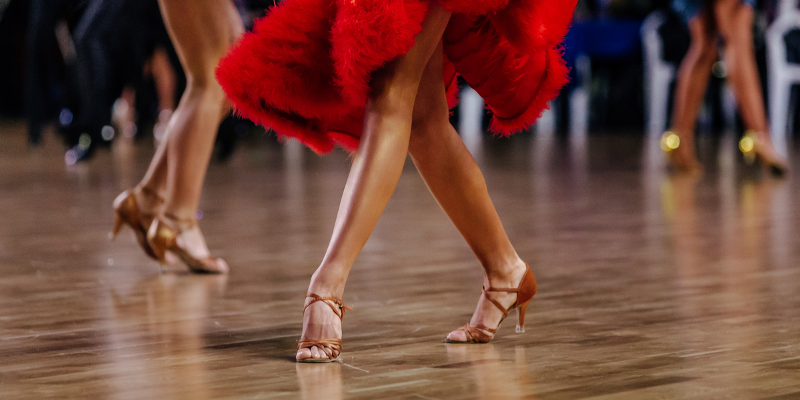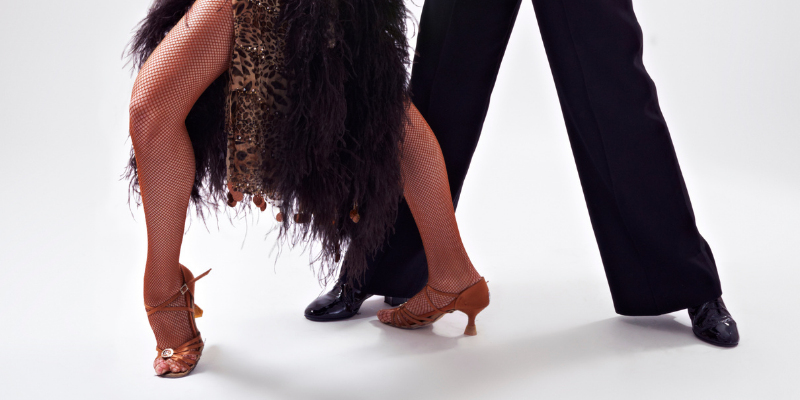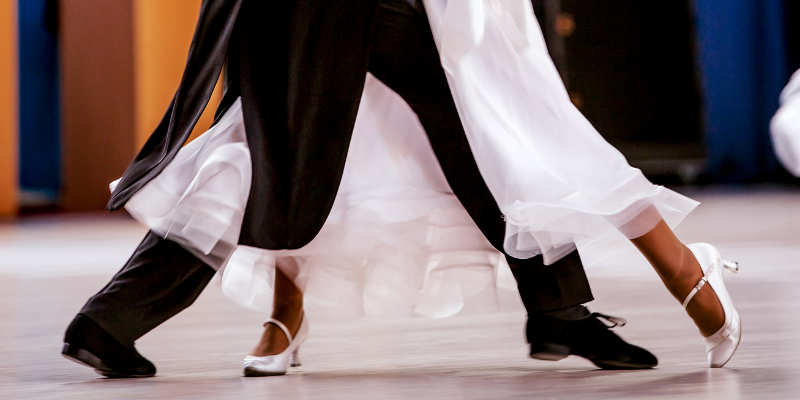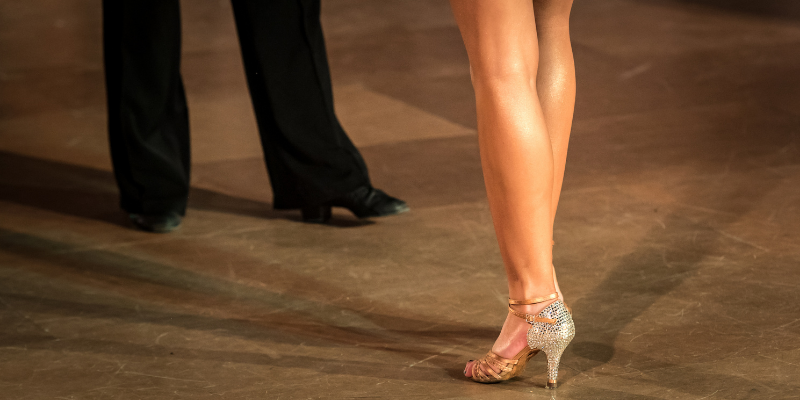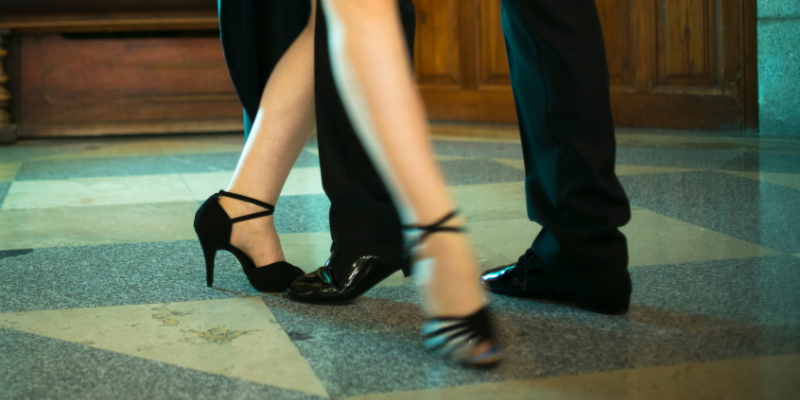So you’re ready to buy ballroom dance shoes, but you’re not sure where to start? Relax, I’m going to walk you through it.
Characteristics of Ballroom Dance Shoes
There are two main features that distinguish ballroom dance shoes from regular footwear. The first is a steel shank for maximum support and durability, and the second is a suede sole. Suede has the perfect amount of grip. Too much grip (think tennis shoes) and your foot won’t turn freely. Too little grip and you’ll slip and slide. Either can result in injury, so if you need to justify the cost of dance shoes, just think of them as safety equipment.
Beyond the basics, shoes are categorized by the type of dancing they’re intended for. For men the choices are pretty straightforward. A classic black 5-holed oxford, while designed for standard/smooth dancing, is a good choice for all around use. They usually come in leather or patent leather, but otherwise there isn’t much variation. If you plan to do mainly Latin/rhythm dancing (or if you want to add a bit of height), you’ll want a Latin shoe which will have a softer, less structured design and a Cuban heel. Smooth leather or suede is fine, but as with the oxford, they should be black.
Women’s shoes are categorized similarly. Where they differ is in the wide variety of styles, colors, and embellishments available. A classic pump, in either leather or satin, is the norm for standard/smooth dancing. Some come with a strap across the instep (which I highly recommend) to decrease the chance of you stepping out them. Shoes for Latin/rhythm dancing are strappier and often open-toed. They are probably the best choice for general dancing. For your first pair you can’t go wrong with a nude or tan color which matches everything, blends with the floor, and elongates your leg line. Sadly, it is still difficult to find shoes that match darker skin tones, so if you can’t find a good match, you may want to have them dyed. Your second pair will probably be black, followed closely by red, silver, leopard, rhinestone… You’ll see.
A third category, for both men and women, is practice shoes. Basically they’re a less stylish (but comfier) all-purpose shoe that you may appreciate if you dance a lot.
Materials
Leather is a good choice for both men’s and women’s shoes. It’s classic, durable, and will mold to your foot somewhat over time. It’s also the easiest to keep clean.
Patent leather may look snazzy, but it sticks to itself, so if you’re brushing your feet as you should be, you can easily trip yourself up. It also scuffs up pretty easily and doesn’t have much give.
Suede has a nice look and feel. Because it’s softer than leather it molds nicely to the foot, but that also means it’s a little harder to maintain.
Satin doesn’t have much give and it’s hard to keep clean. It does however come in an amazing array of colors and can even be dyed to match your attire.
Cost
Don’t waste your money on a cheap pair of dance shoes. They won’t be comfortable, and they won’t hold up. Expect to pay from $100 – $200 for a decent pair from a reputable brand. Oh, and those higher end brands usually come with double padding – sigh.
Fit
Sizes will vary some from brand to brand, so you may have to experiment a bit, but generally you’ll wear your usual size. One exception is with ladies open-toed styles where the toe should come all the way to the front edge (or even slightly beyond), in which case you might need a half size smaller. The shoe should feel snug and supportive. Don’t even think about trying to live with a heel that slips or a toe that binds. You’ll be putting a lot of miles on these bad boys, so they better be comfy. If in doubt, bring them to your next lesson and let your instructor check the fit.
Unfortunately, most dance shoes only come in a medium width. This is particularly problematic for the guys since they have fewer style options. For ladies with a narrow or wide foot, styles that lace or have adjustable buckles may be a good solution. Be careful of very strappy styles however, as they can dig in or allow toes to escape in weird ways. Styles with mesh panels can offer a similar look while still providing good support.
Finally, many companies can accommodate a certain degree of customization, such as two different sizes or different heel heights, but it will cost extra and the sale is final.
Heels & Closures
Men’s heel heights are usually 1 inch for standard/smooth and 1 ½ inches for Latin/rhythm. For ladies the default is a slender 2 ½ inch heel, but fortunately these days there are a lot of other options. Heights from ¾ – 4 inches are usually available, as are varying degrees of flare (how wide it becomes at the bottom) and much chunkier Cuban heels.
Men’s shoes generally just lace up, but because ladies shoes have a strap (or many straps) that can be adjusted, the types of attachments are also more varied. As mentioned before, laces can be helpful in getting a good fit, but they do run the risk of coming untied. Buckles are the most secure, but a faux-buckle clasp is pretty good too, and it’s quicker to take on and off. My favorite is snaps, but they’re not as widely available.
Where to Buy Ballroom Dance Shoes
Unless you live in a large city with a lot of dance studios (Hello NY and LA), you’re probably going to have to order online. Make sure to check return policies before you order, and when you try them on, stand on a towel to keep the suede clean. And remember, custom orders cannot be returned.
Shoe (and dress) vendors also set up booths at large competitions, so if you hear of one coming to your area, it may be worth checking out. I got one of my favorite pairs of all time on clearance at an event.
Alternatives to Buying Ballroom Dance Shoes
If you’re not ready to invest in a dedicated pair of ballroom dance shoes, it’s perfectly fine to dance in shoes you already own. A few simple modifications might be helpful though. If they won’t stay on securely, you can buy shoe bands to put around your instep. They’re basically wide rubber bands that come in colors (black, nude, clear, etc.) to match your shoes. Some are even adjustable. Another option to prevent slippage is double sided shoe tape. I haven’t tried it, so I can’t attest to its comfort or efficacy, but it’s worth a try. And finally, you can buy sued pads with adhesive backs, stick them to the bottoms of your shoes, and voila, your favorite kicks now have a dancing sole.
Time To Shop!
Here are a few links to get you started. I’ve purchased shoes from most (but not all) of these companies and been happy with them.
American Classic Ballroom Dance Shoes
Fun final note – In the eighties male competitors often dyed their outfits to match their partners, so somewhere in Jesse’s stash of memorabilia is a pair of purple satin Cuban-heeled dance shoes.
More Articles That Might Interest You
Do I Really Need Ballroom Dance Shoes?
And if you want to see real people dancing in the wild, then our Gallery blog is just the inspiration you need.
Three Easy Ways to Find Out More About Lessons
Visit our Lessons page.
Contact us at (901) 359 – 6467 or cat@catsballroom.com
Try a free lesson to see if you like it. We know your will 😉
